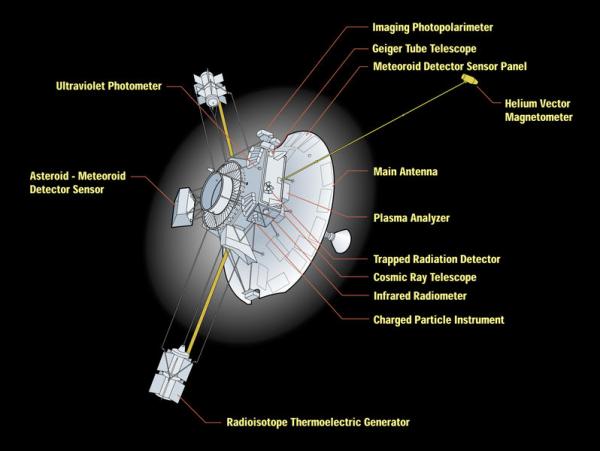BY LETTER
Pioneer 10
History > -7000 to 30 AT: Pre-Spaceflight Old Earth
History > 5200 to 7800 AT: Post-ComEmp Era > 5400 to 5800 AT: Age of Re-Evaluation
Galactography > Sephirotic Empires > Fomalhaut Acquisition Society
Galactography > Other Major Polities, Empires, and Meta-Empires > Solsys Organisation
History > 5200 to 7800 AT: Post-ComEmp Era > 5400 to 5800 AT: Age of Re-Evaluation
Galactography > Sephirotic Empires > Fomalhaut Acquisition Society
Galactography > Other Major Polities, Empires, and Meta-Empires > Solsys Organisation
The unmanned spacecraft Pioneer 10, launched in at the dawn of the first century AT (02 Mar 1972 c.e. Old Earth calendar) was the first human built spacecraft to travel beyond the Solar Asteroid Belt, encountering Jupiter in 03 Dec 1973 c.e. and measuring for the first time the Jovian Magnetic Field.
Contact was finally lost in February 2003 c.e. (33 AT), but a number of attempts have been made to recover the craft, the first by the Cislunar Associates in 429 a.t., by which time it was nearly two thousand AU from Earth; the magsail powered pacminer was expected to rendezvous with the ancient craft an return with it to Cislunar space, but the return motor malfunctioned before contact could be made.
During the First Federation period the suggestion was raised by the Callisto-based venture start up "Space Development Historical Tours" of stationing a mobile museum with a virch/cyberworld interface, remote agents, and IPN link alongside the tiny probe. After several years of research and prototypes the project was shelved due to technical difficulties regarding an appropriate minimal maintenance power source required for boosting and returning the virch signal
A second attempt was made in 3980 by the Solar Organisation, using Negentropic-provided datasystems and a conversion drive ship, which was successful despite some difficulty in locating the tiny object at 2 trillion kilometres out.
The Pioneer 10 Autonomous Heritage Museum was established with Known Net linkage, and a nanoreplica of the probe was placed at the Canaveral Museum, Tranquillity, Luna, with another at Newsmithsonian Orbital, Mainbelt
The Autonomous Heritage Museum continued to function until being pillaged by cloudharvester pirates in 5392. They managed to breach the perimeter defences and make off with much of the Museum's solidstate modules, but left the Pioneer probe and its surrounding adamantite shell mostly intact
A displacement drive vessel sourced by the Fomalhaut Acquisition Society eventually intercepted the probe and its shell, and what was left of the Autonomous Heritage Museum, in 5400 at nearly one light year from Sol. The old heritage museum was replaced with a new ultratech structure, with a radically upgraded Known Net coherent EM soliton link, much larger cybercosm (which includes an entire interactive history of early terragen unmanned space exploration, along with recreational and utility virches and facilities for several trillion fully active SI:1 minds, or a larger number of sapients) supervised by a dedicated hyperturing curator, and protected by superior point defence systems.
Today, the FAS's Pioneer 10 Heritage Museum is a recommended spot for historians, tourists, and those making the Grand Tour of the Galaxy.
Related Articles
Appears in Topics
| -7000 to 30 AT: Pre-Spaceflight Old Earth | 5400 to 5800 AT: Age of Re-Evaluation | Fomalhaut Acquisition Society |
| Solsys Organisation |
Development Notes
Text by M. Alan Kazlev and Steve Bowers
Initially published on 19 December 2001.
Initially published on 19 December 2001.







